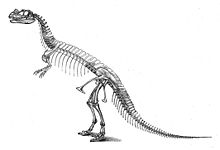Description[edit]
Ceratosaurus, at first glance, looked like a fairly typical theropod,[3] however its skull was quite large in proportion to the rest of its body, and large nasal and brow horns[4] and possessed a prominent nose horn formed from protuberances of the nasal bones.[5] In addition to the large nasal horn, Ceratosaurus possessed smaller hornlike ridges in front of each eye, similar to those of Allosaurus, these ridges were formed by enlargement of the lacrimal bones.[6] Uniquely among theropods, Ceratosaurus possessed dermal armor, in the form of small osteoderms running down the middle of its back.[7] Its tail comprised about half of the body's total length and was thin and flexible with high vertebral spines.[4]
The type specimen was an individual about 18 feet (5.5 m) long; it is not clear whether this animal was fully grown.[7][8] David B. Norman (1985) estimated that the maximum length ofCeratosaurus was 20 ft (6.1 m),[9] an assessment supported by a particularly large Ceratosaurus specimen from the Cleveland-Lloyd Quarry (UMNH 5728), discovered in the mid-1960s, which may have been 22 ft (6.7 m) long assuming similar proportions to the holotype.[10]
Marsh (1884) suggested that Ceratosaurus weighed about half as much as Allosaurus.[4] In Predatory Dinosaurs of the World, published in 1988, Gregory S. Paul estimated that theC. nasicornis holotype skeleton came from an animal weighing about 524 kilograms (1,155 lb) while the large material from the Cleveland-Lloyd Quarry represents a much bigger and heavier individual, whose bulk he estimated at about 980 kilograms (2,160 lb).[11]
The bigger specimen was later assigned by James H. Madsen and Samuel P. Welles to the new species C. dentisulcatus.[12] A considerably lower figure was proposed by John Foster, a specialist on the Morrison Formation, in 2007. Foster used an equation provided by J.F. Anderson and colleagues to estimate mass from femur length, which yielded an approximate weight of 275 kilograms (606 lb) for C. magnicornis and 452 kilograms (996 lb) for C. dentisulcatus.[6]
Discovery and species[edit]
Ceratosaurus is known from the Cleveland Lloyd Dinosaur Quarry in central Utah and the Dry Mesa Quarry in Colorado. The type species, described by O. C. Marsh in 1884 and redescribed by Gilmore in 1920, isCeratosaurus nasicornis.
Two further species were described in 2000: C. magnicornis (from the Fruita Paleontontological Area, outside Fruita, Colorado) and C. dentisulcatus.[13] C. magnicornis has a slightly rounder horn but is otherwise highly similar to C. nasicornis; C. dentisulcatus is larger (over 7 meters), slightly more derived, and has an unknown horn shape (assuming it had them). The Portuguese remains have been ascribed to C. dentisulcatus (Mateus et al. 2000; 2006). However, the validity of C. magnicornis and C. dentisuclatus has been disputed by various palaeontologists,[14][15][16] arguing that the differences from C. nasicornis are due to individual or ontogenetic (age related) variation; thus, they would be junior synonyms of C. nasicornis.C. meriani is a nomen dubium.[17]
More additional species, including C. ingens and C. stechowi, have been described from less complete material. The former is now believed to be a dubious carcharodontosaurid instead, and the latter is a dubious ceratosaur and/or spinosaurid.[18] Ceratosaurus is present in stratigraphic zones 2 and 4-6 of the Morrison Formation.[19]



No comments:
Post a Comment